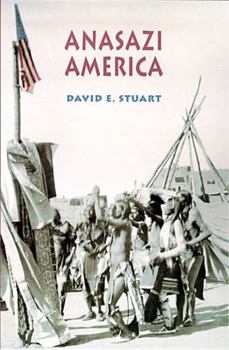Anasazi America: Seventeen Centuries on the Road from Center Place
Select Format
Select Condition 
Book Overview
At the height of their power in the late eleventh century, the Chaco Anasazi dominated a territory in the American Southwest larger than any European principality of the time. A vast and powerful alliance of thousands of farming hamlets and nearly 100 spectacular towns integrated the region through economic and religious ties, and the whole system was interconnected with hundreds of miles of roads. It took these Anasazi farmers more than seven centuries to lay the agricultural, organizational, and technological groundwork for the creation of classic Chacoan civilization, which lasted about 200 years--only to collapse spectacularly in a mere 40. Why did such a great society collapse? Who survived? Why? In this lively book anthropologist/archaeologist David Stuart presents answers to these questions that offer useful lessons to modern societies. His account of the rise and fall of the Chaco Anasazi brings to life the people known to us today as the architects of Chaco Canyon, the spectacular national park in New Mexico that thousands of tourists visit every year.
Format:Paperback
Language:English
ISBN:0826321798
ISBN13:9780826321794
Release Date:May 2000
Publisher:University of New Mexico Press
Length:264 Pages
Weight:1.02 lbs.
Dimensions:0.7" x 6.1" x 9.1"
Customer Reviews
2 ratings
Fantastic review by Michael Adler in "SCIENCE" magazine
Published by Thriftbooks.com User , 25 years ago
"[David Stuart's]characterization of an emerging Chacoan elite is convincingly argued. These debates are far from over, but Stuart's contributions reach out with commendable clarity, backed by well-researched discussions of archaeological evidence and impressive endnotes. Perhaps the book's greatest contribution is a well-crafted dialogue that unites archaeology with our present world. ANASAZI AMERICA contrasts community conflit one thousand years ago with the bloodshed in Yugoslavia and Northern Ireland, making links that bring the Native American past into a tumultuous yet understandable present. Stuart relates the painful circumstances of high infant mortality among the ancestral Pueblo peoples to similarly devastating conditions in less economically developed parts of our own world. Stuart's depiction of the Chaco system as a failed experiment in power politics and overspecialized agricultural startegies is both compelling and correct. From a dry and dusty archaeology, Stuart crafts an understandable story that is depicted in a thought-provoking and contemporary context."--Michael Adler, Southern Methodist University, Dallas, TX. (c)2000 by the American Association for the Advancement of Science
Lessons from the Past
Published by Thriftbooks.com User , 25 years ago
This easy-to-read volume presents an interesting perspective on human adaptation. When to hold on, when to move, when to experiment, or when to commit to new technology are personal or family decisions, yet when made by large numbers of people at approximately the same time, the consequences of each set of choices shapes the future of many generations. The prehistoric Puebloan experiment with the growing power of an elite who organized a broad region through ritual and economic exchange failed when drought forced the movement of farmers to upland areas. They made several changes, each time making adjustments that eventually resulted in reorganized groups living in more ecologically diverse lands. Stuart combines anthropological theories and data in his fascinating and thought-provoking comparison of past and present Puebloan lifeways with contemporary America. Will we have the foresight to recognize the consequences of our choices for long-term social good and make intelligent decisions? Will we endure and survive?






